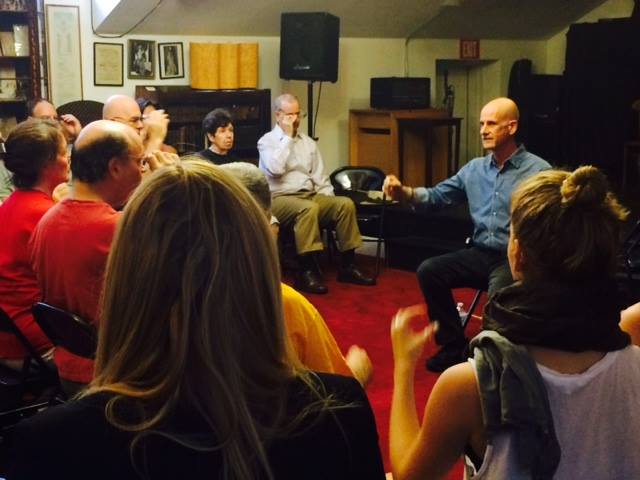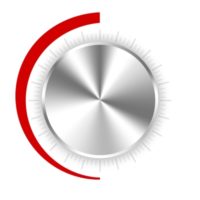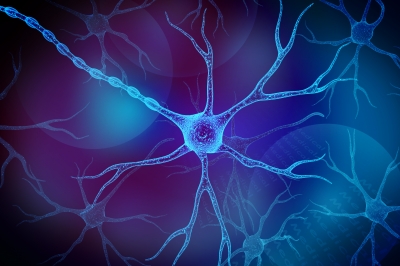Core and spark. Neck loose, head moving up—Slowly hinge back in the chair using your hip joints as hinges. Think that your legs are moving away from your torso from your hip joints. The further you hinge back, the more your abdominal muscles will engage. You might add some forward head rotation, paying special attention to keep freeing your neck, even as other muscles engage. Come back to neutral and release all excess tension. Smile, breathe, then repeat. Mark
Hand to mouth not mouth to hand. Today, my friends, try this. Bring y0ur food to your mouth rather than your mouth to your food. Stay back while eating and eliminate that hungry hunch. It’s going to feel quite different, regal perhaps, and you might even find yourself enjoying your food in a different way. Different is good, right. Bon appétit. Alan
Brush your teeth. How much effort do you need to brush your teeth? Probably half as much as you’re using, and your dentist may agree. What happens if you think of the toothbrush as an extension of your fingertips, and move it towards your teeth with only the effort needed? When you get there, use more fingers and wrist, less shoulder and bicep, because when it comes to your teeth—easy does it. Mark
Jaw Breakers. If you’re of a certain age, you remember the jaw breaker, a large round, rock-hard piece of candy, the girth of a softball, or so it seemed at a tender age. It financed many a dentist’s patio. You might be doing some jaw breaking of your own, or at least some jaw holding. If so, then: Remember that your jaw is an appendage of skull, and there is anatomically no upper jaw. Really. There is jaw and there is skull. Again, no upper jaw. Right now, with lips closed let the jaw come away from the skull, teeth apart, and hang out there a bit. You can continue whatever you’re doing all the while. Think of the jaw rocking gently forward from the skull without moving it. Then let it come back. Rock it back and forth between those opposing thoughts without actually moving it, teeth still apart. For a little more sweetness, smile behind the eyes. Let your whole head effervesce, so to speak, all those tiny bubbles rising toward the top of your head, jaw contributing. Alan
Don’t hold that thought. When you catch yourself thinking that same old habitual thought; you know—the one that’s not helping at all… observe it. Then, do a few whispered ah’s. Think about freeing your neck, your shoulders, and your jaw. You’re changing the quality of the thought. Mark
Sag equals sad. In the Times Mini Puzzle, Clue: Giving in to gravity. Three letters. You know the answer. Sag. If there is a popular notion that giving into gravity is sagging, the same notion entertains the possibility of skillfully opposing gravity, using it as a positive force. If the chain is aflop on the ground it can not be lengthened from its middle, but from it’s end. To oppose sagging, then, begin by freeing your neck so that the head can free forward and up. Think it and continue in your thinking. Let your heel release away from your foot as your head releases away from your torso. Isn’t that delicious? Your torso does not own your head. Free your neck in order to let into length. Giving in to gravity? Sad. Alan
Eyes Rule. While seated, neck freeing, heading rotating forward and up—
turn your head to the left, then right, then front. Notice the effort. Now, neck freeing, heading rotating forward and up, move your eyes to the right first, and then let your head follow. Eyes left, then head follows. Does it feel easier? Mark
Head forward and up. Think of letting your hand and arm arise, index finger pointing up, open palm toward your head, five or six inches distant, more or less. Now comply with that wish. Oops, your’e already there aren’t you. Try it again and think it first. Let your right arm, if that’s your choice, arise and open from your left hip. Think of turning your hand within itself, turning in place, index finger wishing, only wishing to point forward in front of you, base of the palm turning back. Just think it.Got it? Now imagine your hand attached to your head by slender threads, by a web, by the stickiness of air. Turn your hand again and think, head forward and up, head forward and up. Free your neck while doing so. Alan
Moving and not moving. Standing still is not fixity.It is more like swimming in air than fixity. We are constantly tuning our stance in order to remain in equilibrium. Even while standing stork-like, one footed, it is best to think of motion. When putting on your pants, let the foot that remains on the ground be a walking foot, having the impetus and thought of forward even while remaining in place. Alan
The eyes have it. Focus on something, and gradually see more and more with your peripheral vision. Include the vertical along with the horizontal. Free your neck, free your jaw, head forward and up. Notice what you’re hearing, smelling, and touching. Add a smile as you let the world come to you; all while staying focused. Mark
Wings of eagles. You may know we’ve got eagles here, yes, eagles. Imagine their being just above you and the trunk of the tree in which they’re perched growing right through you and rising above your head. Raise on hand or the other quite high and point to them. Touch their beautiful whited heads. Turn your hands gently, easily. Give them a little forward and up, the fingers turning forward the heel of of the hand turning back and moving only slightly or not at all. Let all the dynamism of your hands be expressed in your turning. Feel it in your feet. Free your wrists. Touch their heads in you minds eye, but don’t ruffle their feathers. Stay there. For me, it is ineffable, lovely. For you too, I hope. Alan
Constructively Resting. Lie on the floor with your head resting on a few books. See what you have to stop doing—in order for you to lengthen. And widen. If you’re breathing became fuller you’re on the right track. Mark
A Thousand Points of Might. You’re lying in bed thinking about, maybe dreading, getting up, and suddenly you find yourself standing, feet on the floor, ready to go. How did that happen? What if you could bring that same sort of spontaneity and ease of action to your work, to your practice? Well, you can and it needn’t take quite so long as it took you to get up. If fact, you can easily insert 2o, 30, perhaps more of these little moments throughout your day. Choose an action, mundane or momentous, and wait. Think the action without muscling it and in due time, comply. Continue to connect in this way with other actions, a thousand points of might. Take command of your moments, take command of your day. Alan
The 7 second break. People routinely sit at the computer eight hours a day, and more. Everyone knows to “take frequent breaks”. But what happens during those breaks? Usually, not much. When the break is over we just go back to the way we were. An Alexander Technique break is different. In 7 seconds you can:
1. Take your hands off the computer.
2. Free your neck and have your head rotate forward and move up.
3. Leading with your fingertips place our hands back on the keyboard (without unnecessarily raising your shoulders)
4. Think of something that makes you smile. Mark
Standing is not fixed. It is more like swimming in air than fixity. We are constantly tuning our stance in order to remain in equilibrium. Even while standing stork-like, one footed, it is best to think of motion. When putting on your pants, let the foot that remains on the ground be a walking foot, having the impetus and thought of forward even while remaining in place. Alan
The Earth beneath. In my training to become a teacher of the Alexander Technique (1600 contact hours over a period of three years) there was a recurring exercise that mystified me for a while. We’d place a sheet of paper on a soft massage table, worm our fingers and hands underneath the paper, and lift it. Could we feel that change in our feet, in our contact with the ground. Are you kidding me? First, it’s not an easy feat getting your fingers under the paper without overly ruffling it, or crushing it, which is frowned upon. Wrists, joints of the fingers, have to be free and flexible, a gift within itself. And to feel contact with the Earth, ankles, knees, hips, back, torso have to be free as well. So, stand up. Leave your keyboard for a moment, and place a piece of paper before you on your desk or table. Place your hands on the table palms up. Unlock your knees so your legs can bend, send the knees forward, bend them a bit coming back to erect standing when you’re ready, knees not locked. Breathe. Rotate your wrists now to let the hands rest on your desk, palms down. Remove your hands to let your fingers tap, tap, tap, on the crease between your legs and torso and then back to the desk, palms down and again to that crease, tap, tap, tap. Hands on your desk, now, let your fingers begin to feel the edges of the paper on your desk, worm them about to find their way under the sheet of paper. Now, all at once and all together, send your knees forward and your hips back slightly, just where you’ve been tapping, and let your fingers find their way under the paper. Wait. Lift the paper, raise it. Do a little circular inventory: Toes, ankles, knees, hips, neck. Where am I doing too much. Undo that. Do you feel the change in your feet, in their contact with the ground. Yes, I do, and so what, you might say. We’ll you’ve awakened your body, freed your joints, and become a communicator with your Department of the Interior. You’re going to love it. Alan
Two diaphragms, the thoracic and the perineal. Breathe from your diaphragm is a widely accepted piece of advice, and like most widely accepted pieces of advice, prone to some misinterpretation. First, we need to locate our diaphragms and yes, there is more than one. That diaphragm protected by your ribs—the thoracic diaphragm— is the floor of the thorax and the ceiling of the abdomen. It is not down there in the abdominal area where we tend to dislocate it. The other diaphragm— the perineal—is anchored equidistant between the sexual organs, and forgive me, the anus, yes, way down there, and it is equally important to our breathing as the thoracic diaphragm.
Leaving the care of prominent physiatrist in New York, a patient was advised, forget everything we’ve worked on together if you must, but don’t forget that every breath begins with a descent of the perineal diaphragm, the base of the pelvis. That expansion of the perineal diaphragm is followed, “one after another and all together” (F. M. Alexander’s words) by the concentric expansion of abdomen, ribs, back, and a bit in the chest as well, a whole facilitated by the part, by the vitality of our perineal diaphragm. Can we embrace that possibility together?
In sitting standing, or lying down—in a place of comfort—take in all the data of your surroundings, those within in your room and without. Take it all in. That data, your surroundings, establish you, build you up. Air too is buoying you up, trying to reclaim the space of which you’ve robbed it. Let your self be supported by it. Notice your breathing, its rhythm, its changing tempo, and just continue noticing. Let every part of the ensemble of your self respond to its conductor, the descent of the perineal diaphragm. Let your self be breathed. Today, every day, there is nothing better for your sanity, for the soundness of your body and mind, than to take this little breathing break. And thank you, little fellow, thank you perineal diaphragm for your willingness, for your vitality, and above all your flexibility. Conduct away. Alan
With cat-like tread. You may know the Gilbert and Sullivan number by the same name: With Cat-like Tread. It’s customarily and ironically performed with great stomping about, the purportedly stealthy pirates, those of Penzance, making a hell of a racket: Pound! Bam! Grind! Plotz! No feline has ever been so clumsy. For the cat, the last part of the advancing rear foot to leave the ground is the toe, an act facilitated by that oh-so-flexible feline ankle. We might feel those kitty ankles in our own comparatively Frankensteinian walk. Let the toe of your rear-most foot to be the last thing to leave the ground. Let it peel from the ground rather than being lifted off flat. Way too much work. Cherish all of your foot’s rocking and evolving contact with the ground. Don’t pound the pavement with your flat feet. Oh, what a favor you’ll do yourself, even you Alexander cats. Walk with cat-like tread. You’re going to love your contact with the Earth. Alan
Stand up and find yourself some blank space on a wall, enough to accommodate your frame and your posterior. Stand with your back toward the wall and your heels close to the wall, one to three inches away depending on your size. You’ll find what is best. Your posterior, contingent upon the abundance of your blessing, will likely be touching the wall. If you need more space inch your feet forward a bit. You do not want to lean back against the wall. You definitely do not want to flatten your back against the wall. Stand a moment back toward the wall and adjust your self for comfort. You can definitely find your spot. Now, think, my knees can go forward a bit. They can bend. Just think it; wait; and in your own good time comply. Send you knees slowly forward , not too much, and let your back slide down the wall just a bit in synch with the forward movement of your knees. Not too much, not too far. Find a comfortable spot and stop. Remain there a moment and come back to standing. When you repeat the exercise, you may find some freedom in your hips that allows your knees to go forward even before the back begins its movement down the wall. If so, let that happen. That’s the ideal, but not one that you need to worry about or enforce. Give it a try once more. Knees forward. Freeing hips; back complying to receive the support of the wall as its downward movement begins. Work with it. You will absolutely find something better for yourself than I’m able to explain. It’s a wonderfully supportive exercise, and at work, a little vacation from you desk. Not Tahiti, maybe, but a vacation nonetheless. Alan
Claiming your inheritance. Walk, sit, and stand the way you imagine yourself as a King. Or Queen. Or President. Or whomever you admire. Mark
A stolen moment for your self and the Alexander Technique. You work hard for your money, type too much, sit too long, stare at the screen. Not too much to be done about that, except stand up a couple times an hour, maybe even walk around your desk. Radical stuff. But then there is this, a thrilling little break for your compressed back and arms. You’re going to need an adjacent chair sitting right next to you, one with a back. In a moment you’re going to drape an arm over the back of that chair, but wait. Think it. Wait. Comply. Don’t even think of beginning without this mindfulness triad. Let your arm drape over the back of the chair now. Remain there a moment. Direct your arm to let away from your torso. Direct your back to let the arm away from your back. Free your wrist in order for the hand to let away from the arm. It might start feeling crazy good about now, perhaps even unbearable. And still remain. Tomorrow, the rest of the story, but doesn’t this feel great? Alan
Connect your dots. Free your jaw and soften your eyes. Free your forehead and let go of any gripping in your toes. Release your legs away from your torso and slightly smile. Free your ankle joints and your lips. Mark
You and your cell phone, a crippling relationship. Unless you’re an Ali, an Astaire, a Tallchief, or a Baryshnikov, your cell phone is likely crippling you. You’re contorting when you use it, collapsing into the shape of a crumpled C, which in posture, is a failing grade. You are crushing your capacities, altering the secretions, compacting your organs, and pressing on your joints. You can do better. Create space between you and your device. Imagine that between you and your iPhone there is an elaborate, articulated structure. You may construct it in your mind’s eye of any sort of material, bamboo, metal, the material of which spiders spin their webs, anything. But make sure it folds, that it is articulated, attaching to all of your joints, from your phone to your vertebrae, to your forehead, to your knees, and your hips. Any time you move your iPhone or your torso, those articulations open or close. They breathe. Move your iPhone away from you, the articulations open, expand, they inhale, and insomuch as they do, you inhale as well. It’s a dance with your iPhone in which you lead rather than the other way around. Let the space between you and your phone be plastic, malleable. You can manipulate it. Hold the phone in front of your face from time to time since that’s where your eyes are. Hold it in front of your face and let your back stay back. Bring the phone to you, if you please, not your self to the phone. Act as its master, not its captive. It will be a healthy change. Alan
Hand on the table. A European acquaintance of my age relates that in his home, children were required to keep one hand flat on the table while dining. I believe that directive might cause some insurrection these days. But at your desk it might be just the thing you need for a quick break. Place one hand there or on any flat surface and give your arm to the surface and let your hand melt on. Let the arm come away from torso. It is not owned by the torso you know. Moreover, let your left or right arm release from the opposite hip, back lengthening and widening. Now as subtly as you can, and more subtly still, send the desk away from you without moving you hand. Let your back let back. There now, and back to work. Feels a bit better, no? Alan
Staying back. There is a power within you that can be used for good or ill, namely, staying back. Waiting, becoming aware of your back’s lengthening and widening, making the space between you and another plastic and inviolate will create a space that a weaker individual must fill. He or she may unwittingly disclose information that may create advantage for you. It is a skillful, but perhaps unfriendly use of your self. But otherwise employed, it can create an atmosphere that allows another to share more freely, to open into that space that you’ve provided. I watched it work yesterday in meetings with government officials. I entered their offices determined to stay back, and these officials, notoriously difficult, were jovial, looking directly at me, smiling, and yes sharing some jokes. No, it doesn’t always work like that, but staying back does remove the confrontational element, violating another’s space, leading with the forehead (front, in French.) Do stay back, then, not for advantage but in respect of another, maybe even out of love. Stay back. Use responsibly. Alan
Walking a new walk. Want to investigate your walk, improve it, or at least change it? Come to standing if you’re not already there. Stand in repose, feet immediately under you, and think of taking a step forward. Wait. In a moment comply, take a step, but step backward to come onto your the toe of one foot.. Remain there a bit. Challenging, no? When you were stepping back, you may have noticed that you’ve become temporality one-footed. You may have noticed too that your stable foot was gripping the ground something fierce. The challenge is to fully let your stable foot receive the support of the ground without tensing or gripping. Think of that foot opening into the floor, toe lengthening from your heel. Now, standing again, both feet beneath you and try that again. And for still more fun, let one hand rest on back of your neck. I’ll wager you find something excessive going on there. Try again, if you want with your neck remaining free. Now, after that bit of investigation, begin again, and set out forward into a walk and notice what has happened. Wouldn’t you like to walk like that all the time? Well, if you’ve done it once, you can do it all the time. Continue to work and let me know about your issues with this if any, or just send a progress report. Walk a new walk. Alan
Fingertips lead. When you get where you’re going, that’s what you’ll be using. Move them with only the necessary effort to get them there. MarkNumber Four: Gesamtkunstwerk! Bless you. Gesamtkunstwerk is a term for a fully integrated work of art. It was coined by Wagner to apply to musical works, namely, his own. There is a Gesamtkunstwerk of the self and it’s called, rather simply, a squat. A squat is a primordial thing, a listening pose, a pause before action, a conservation of energy. Need a prescription for grogginess at your desk: Try this, a nice juicy squat. Stand up. Feel the contact of your feet with the ground. Unclench them toes. Free your knees. Send them forward. let them bend just a bit to send them right over your feet, but not too far, not too acutely. Should this hurt stop there. Come back to your fully upright position. Find the crease between torso and leg and tap there gently with a finger or two. Think, this is where I fold to come into a squat. Pause now, and all together, send the knees forward and the hips back, still tapping at the crease, to come into a squat. Breathe while your down there. You might want to adjust your squat, knees freeing and going forward, torso finding a deeper place for your squat. It’s a quick pick me up. Now back to those desk chains but remember, there is always time for a nice squat. It’s primordial, yours by birthright. Alan
Think of something that makes you smile. Wait. Ask. Has my breathing changed? Mark
As the World Turns. As you move today, as you step out, walk as though you were spinning the world. Place the world under your feet, quite a bit smaller than it actually is, and as you walk let your feet’s contact with the ground rotate the world. Let your feet stay in contact with the ground for as long as they can. Let the back foot peel off, the last part to leave the ground your flexible big toe. Push off from that toe ever so slightly as the world turns. Cherish that worldly contact. Melt your feet into the ground. Now, now does that feel? Alan
Your main squeeze. Think. Air beneath, air above, air around, air between. Air is matter. It has substance, weight. It’s squeezing you all around, trying to reclaim the space of which you’ve robbed it. Let it buoy you up, all day, every way. Alan











Leave A Comment